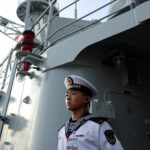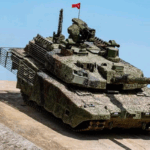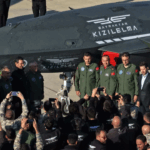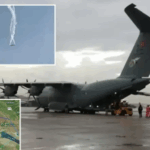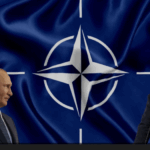The article highlights the urgent need for European NATO members to strengthen their own defense capabilities against Russia. This is especially important considering the possibility that the United States may be stretched thin by simultaneous conflicts in other regions.
Despite Russia’s significant military expenditure, Europe has not invested enough in its own defense. The article calls for increased European military spending, larger land armies, and improved logistical support within the next three years. It also encourages Europe to reduce its reliance on US forces and enhance its ability to deter Russian aggression independently.
Key points:
- Russian Threat: Russia’s aggressive actions in Ukraine and Georgia highlight its threat to European security. NATO’s new strategic concept acknowledges the possibility of an attack on member states.
- Economic and Military Growth: Despite sanctions, Russia’s economy is growing, and its military spending is increasing significantly, with impressive production of military equipment.
- European Defense Shortcomings: European NATO members have not matched their rhetoric with adequate defense buildups. Their military capabilities, especially on land, are insufficient compared to Russia’s.
- Dependence on U.S.: European reliance on U.S. military support is risky, especially if the U.S. is engaged in conflicts elsewhere. European countries must take greater responsibility for their own defense.
- Action Plan: The article calls for European NATO members to increase defense spending to 3.5% of GDP, build larger land armies, improve logistics, and create an integrated European defense industry. It also suggests establishing a proportional relationship between U.S. and European battle-ready troops to ensure fair burden-sharing.
The overarching message is that Europe must urgently enhance its defense capabilities to deter Russia and reduce dependence on the U.S. for security.
Read more below.
Urgently Needed: A Europeanized NATO
Russia has shown by its expansionist and illegal wars against Ukraine and Georgia that it is a chronic threat to the peace and security of Europe. In case of a simultaneous attack on U.S. allies by China, Russia, Iran, and North Korea, the armed forces of the United States would be stretched thin. Europe’s democracies must urgently make and implement plans to deter Russia, even if assistance from the United States is limited due to Washington’s potential commitments in the Pacific and Middle East. They have just a few years to achieve this objective.
American presidents have demanded for several decades that European NATO members take much greater responsibility for their own defense, to no avail. To encourage focus and urgent action, the United States should tie the continued presence of U.S. troops in Europe to the formation of a credible European NATO deterrent.
The Russian Threat to Europe
A Russian attack on a NATO member is no longer unthinkable. Indeed, NATO’s new strategic concept says as much: “We cannot discount the possibility of an attack against Allies’ sovereignty and territorial integrity.” And yet Europe’s rhetoric has not been convincingly matched by a defense buildup commensurate with the new level of threat. On the other hand, Russia has managed to increase its defense capabilities while taking losses in the war in Ukraine.
The Russian Economy and Military Spending
Despite sanctions and inflation, its economy is expected to grow 3.2 percent in 2024 compared with 1 percent in the EU area. Russia’s planned military spending in 2024 would be 29 percent higher in real terms than in 2023, totaling 7.1 percent of GDP and 35 percent of all government spending. These are levels comparable to those of the Soviet era.
The country’s defense spending is even more impressive when adjusted for purchasing power parity (PPP). This is a more accurate way to estimate actual military resources, given Russia’s lower costs for labor and other inputs compared to those in the West. The Economist started with military spending estimates from the Stockholm International Peace Research Institute (SIPRI) and adjusted for lower costs. Using this methodology, Russia’s 2023 military spending (in PPP dollars) was nearly $400 billion—more than half of the $719 billion spent by the European NATO members plus Canada, not the mere quarter or less that is usually assumed under standard GDP calculations. This helps explain Russia’s ability to stay in the fight despite vast losses. It is also a warning to Europe that the margin of its economic advantage in the rearmament race is much smaller than commonly understood.
According to a 2023 year-end Russian Defense Ministry report, the defense industry produced 1,500 tanks, 2,200 armored combat vehicles, 1,400 rocket and artillery vehicles, and 22,000 drones.
The Russian Military
Russia has suffered significant losses in military personnel and equipment in the Ukraine war. Despite this, the Russian army is 15 percent larger today than when it invaded Ukraine in 2022. Russia’s armed forces now number 1.3 million people. In Ukraine, it has 470,000 battle-tested troops—more than the entire active U.S. army.
According to a Hudson Institute study, “the Russian military possesses roughly 5,750 main battle tanks, 9,000 to 10,000 other armored platforms, more than 10,000 pieces of tube artillery and mortars, and more than 3,000 rocket launchers.” Its combat formations may have up to 7,500 pieces of towed artillery.
The Next Russian Aggression
European officials are debating when Russia may attack NATO. Germany’s defense minister, Boris Pistorius, has warned that “Germany must be ready for war by 2029” as “we must not believe that Putin will stop at Ukraine’s border.” Norwegian Chief of Defense Eirik Kristoffersen suggested that NATO had only two or three years to prepare for a Russian attack on the alliance.
The current Ukraine war of attrition will likely result in some sort of armistice. That would free up a resentful Russia to leave some forces on the Ukraine border and aim the bulk of its military to attack NATO countries to its west. It has a large military and a humming war economy. The logic of war may now be hardwired into Moscow’s politics and planning.
Europe must strengthen its deterrence against Russia
European Military Capability
Collectively, the EU countries compare favorably to Russia in terms of population (449 million vs. 143 million), total GDP ($18.4 trillion vs. $2 trillion in 2024), and GDP per capita ($40,824 vs. $13,817). Adding the UK to this comparison only widens the difference. However, these European advantages do not translate into battle-ready military superiority.
During the Cold War, the average military spending among European NATO countries was 3 percent of GDP or more. This figure had fallen to 1.5 percent by 2014 but later rose to 2 percent this year.
Since the year 2000, Russian and Chinese defense spending has grown by 227 percent and 556 percent, respectively. In the same interval, the corresponding number for European NATO countries and Canada is just 22 percent. After decades of underinvestment, this is not a sufficient increase. Importantly, according to a paper published by the International Institute for Strategic Studies (IISS), they don’t have much to show for this spending.
The air, naval, and cyber capabilities of European allies may be superior to Russia’s, but they would be unlikely to sway the outcome of a war. The decisive fight would be on land, and in that domain, the Europeans are clearly not strong enough.
On paper, the armed forces of EU members are very impressive at 1.9 million. However, few European countries can field a fully equipped and trained brigade (about 5,000 people) that can be engaged in high-intensity warfare for several weeks. Some military analysts call it a Potemkin force because of its low readiness and untested ability to field a unified fighting force without U.S. support. In contrast, Russia’s military has traditionally used mass and been willing to take significant losses to achieve objectives.
Insufficient European mass
The number of combat battalions (up to 1,000 people) in some of NATO’s largest armies hardly increased between 2015 and 2023, even in the face of mounting Russian aggression. According to The Economist, France and Germany each added just one battalion’s worth of forces, and even Poland added only two. Britain has lost five.
A recent report from the European Council on Foreign Relations warns “that many European armies have become ‘bonsai armies’ with extremely limited force volumes that only offer samples of major capabilities rather than large and robust combat-ready forces.” At the core, they are exquisite but miniature versions of the modern force model offered by the U.S. military. For more than two decades, most European defense planning has neglected the issue of mass.
The UK is the largest defense spender in Europe. A report by the Royal United Services Institute (RUSI) argues, “the trend in the UK military over the past thirty-five years has been to trade numbers for sophistication, which has led to a diminution of total firepower. The UK can do some things well, but not at a particularly impressive scale, especially when the adversary is a state with significant military power of its own.”
According to a Wall Street Journal article, the British military is in the process of downsizing. In 2020, Parliament approved the most significant defense spending increase since the Cold War. Nevertheless, actual troop strength will continue to decline to 72,500 personnel. The British Army’s 227 tanks will be replaced by 148 more modern models, which won’t be ready until 2027. Of its existing tank arsenal, only 150 can be deployed with a thirty-day warning, and only forty are fully operational at any one time.
Germany has Europe’s largest economy and population. Yet its army maintains a force of only 180,000. During the Cold War, West Germany could boast a force of 500,000 with 7,000 tanks, while East Germany could martial 300,000 men. Only 30 percent of the German army’s self-propelled howitzers are operational, according to local media. Tank preparedness is not much better. According to Spiegel, a leading German magazine, the Bundeswehr possesses about 300 Leopard 2 battle tanks, but only 130 are operational. In one exercise with eighteen Puma infantry fighting vehicles, all of them broke down.
Similarly, according to another Hudson study, war simulations demonstrate that the UK military would deplete its arsenals in about a week. Germany would find itself out of munitions in a matter of days or, depending on the scale of the fighting, even a few hours.
Dependence on NATO mobilized mass is untested.
European NATO members rely on the New NATO Force Model (NFM) approved at the 2022 Madrid summit. When fully implemented, it is supposed to provide well over 100,000 troops in ten days, 200,000 in thirty days, and 500,000 in 180 days.
A 2023 IISS study suggested that NATO European land forces may not be at a sufficient readiness level to meet the NFM objectives. It argued that they would need “ambitious improvements to collective training, equipment availability, and logistic stockpiles.”
Risky dependence on U.S. support
Will America be willing to help?
European allies see the 100,000 U.S. troops on the continent as a battle-ready core force for any initial fighting. They will count on additional troops being later transferred from the United States in the event of a conflict as well. They believe that the mutual assistance Article 5 of the NATO charter creates an obligation for America to go to war to defend them. And while many in America agree. There are also other perspectives.
As one of the authors has noted, the NATO charter signatories indeed obligated themselves through Article 5 to assist each other “with such actions as it deems necessary, including the use of armed force.” However, they also agreed to the Article 3 requirement that they “maintain and develop their individual and collective capacity to resist armed attack.” Countries that do not live up to their Article 3 spending obligations should not expect the mutual defense benefits of Article 5.
President Trump expressed publicly and forcefully a widely held view in the United States that many European countries are free riders. He was not the first American president to do so. President Dwight Eisenhower admonished NATO members against “making a sucker out of Uncle Sam” by not committing enough resources to their own defense. Barack Obama said in a 2016 interview, “free riders aggravate me.” His Secretary of Defense, Robert Gates, warned that “there will be dwindling appetite and patience” in America for supporting countries that don’t invest in their own defense.
Will America be able to help?
The 2024 report of the Commission on the National Defense Strategy notes the increasingly close relations between China, Russia, Iran, and North Korea and “the very real threat of simultaneous conflict in more than one theater.” Russia could attack Europe, while China could attack Taiwan, North Korea, or South Korea. Similarly, Iran could launch attacks in the Middle East. Under such a scenario, U.S. military resources would be seriously stretched under the current “one major war” standard for the conventional force.
It is often argued that fighting in Asia would require mostly U.S. naval and air forces, while European fighting will mostly call on ground forces. This is only partly correct and too comforting. Air defenses would be in strong demand in both theaters, as would logistic assets for strategic air and sea lift. Even more critically, in practical terms, it is extremely difficult and taxing both politically and economically to fight one great power war, let alone two at the same time.
In other words, should the United States be involved in a conflict against China over Taiwan, the odds that it would come to Europe’s defense if Russia simultaneously invades a NATO country are much lower than in the case of sequential conflicts.
An Urgent Three-Year Action Plan
With a sense of urgency, European NATO countries must develop plans to have the people, weapons, supplies, and transports to defend themselves with limited U.S. support. Meaningful work must start shortly to be ready in three years.
Increase defense spending to 3.5 percent in three years.
During the Cold War against the Soviets, European countries consistently spent over 3 percent of their GDP on defense. We are again in a new cold war, and there is a hot war in Europe. Poland, a frontline state, is at 4 percent and has decided to jump to 5 percent next year.
Build larger European country land armies and multiply exercises for combined forces.
Reuters reported in July that, according to a military source, NATO European countries discussed forming thirty-five to fifty extra brigades, approximately 175,00 to 250,000 troops, in order to meet the new defense requirements agreed upon by the alliance. Forming a cohesive fighting force requires an increase in the frequency and size of the exercises for the thirty-two European members of NATO.
Create an integrated European industrial defense base.
According to a European Parliament briefing, the European defense industry is too fragmented. Only 18 percent of the investments and procurements are collaborative. Defense companies are national, and demand comes from national governments. This creates numerous problems regarding economies of scale and interoperability. For example, Europe produces seventeen types of main battle tanks while the United States manufactures only the M1 Abrams.
Improve European mobility for personnel and supplies.
Logistics and support are essential to success in warfare. Moving forces and equipment over significant distances requires transport platforms, engineering, and bridge-building tools. European logistics capabilities need urgent improvements. The EU and NATO launched efforts in 2017 to improve military mobility and expanded them in 2022, but these were under-resourced.
Establish a proportional relationship between U.S. and European battle-ready troops.
For decades, U.S. leaders have asked their European counterparts to do more for their own defense. This was to no avail because European governments figured out that there would be no consequences if they ignored U.S. requests. This must change.
Former National Security Adviser Robert O’Brien recently articulated a Trump foreign policy of “peace through strength.” In that context, he argued that “Washington should make sure that its European allies understand that the continued American defense of Europe is contingent on Europe doing its part.”
In a Wall Street Journal op-ed, former Secretary of State Mike Pompeo introduced the idea of a 20 percent cap for the U.S. contribution to a Ukraine aid fund. The level of this cap notionally relates to the about 16 percent share of the United States in the common funding scheme agreed to by the thirty-two NATO member countries.
This “proportionality concept” should be extended to the U.S. force posture in Europe through an agreement that the number of U.S. brigades in Europe should be no more than 16 percent of the total number of battle-ready allied brigades. So, if the United States is to maintain its existing five brigades in Europe, the Europeans must form within three years at least twenty-six battle-ready brigades of their own for a total allied force of thirty-one brigades.
Pulling More Weight
Earlier this year, NATO’s secretary general observed that confrontation with Russia is a reality and will last decades. The expansionist bloc countries of China, Russia, Iran, and North Korea are rapidly growing their military capabilities and have shown themselves willing to use and threaten to use military power to achieve their revisionist aims.
The wealthy and populous nations of Western Europe nations, in particular, must summon the political will to move—and move urgently—to shore up the defense of their freedoms, security, and prosperity. Relying on America’s protection as a substitute for their own national strength is not a sound strategy.
From across time, one of Europe’s great statesmen has a fateful question for today’s European leaders. In a 1936 speech to the House of Commons, Winston Churchill asked this question: “Will there be time to put our defenses in order.. or will the awful words ‘too late’ be recorded?”
By:
Lt. General (ret.) Keith Kellogg was a National Security Adviser to both President Donald Trump and Vice President Mike Pence. He is currently Co-Chair of the Center for American Security at the America First Policy Institute.
Dan Negrea served in the U.S. Department of State as a senior advisor in the Secretary’s Policy Planning Office and as the Special Representative for Commercial and Business Affairs. He is a Distinguished Fellow of the Atlantic Council’s Freedom and Prosperity Center.
Source: nationalinterest.org



